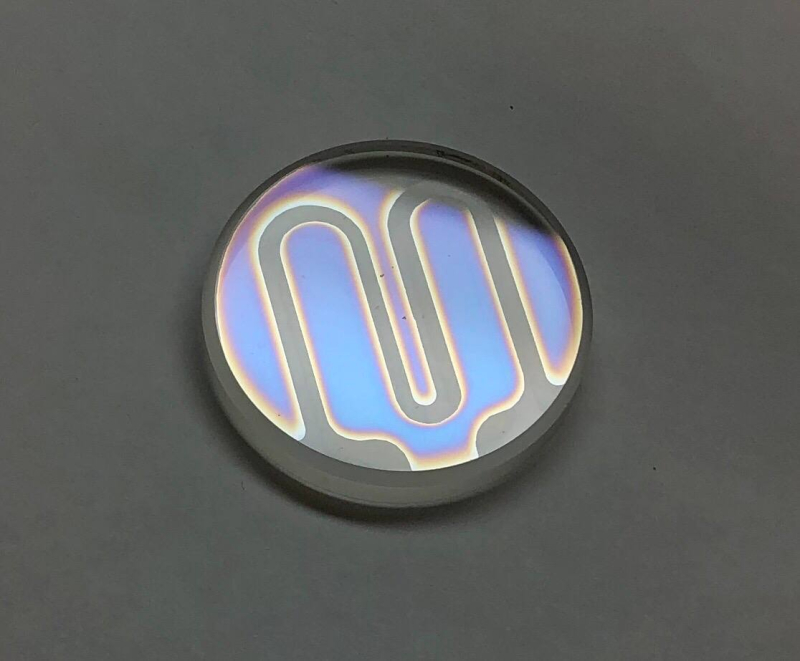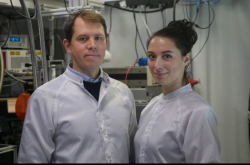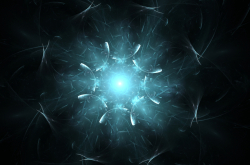Capable of setting field configurations, ion traps can be used to localize charged particles, making them levitate, and move the trapped particles along the trap axis. Such traps are most common in mass spectrometry, i.e. an analytical technique used to identify the chemical composition of substances for the purpose of science, as well as environmental, chemical, and geological studies.
The researchers from ITMO University presented a new version of an ion trap that combines two distinct approaches: optomechanics and nanotechnology.
The developed trap is a glass substrate with two U- and W-shaped electrodes based on indium-tin oxide (ITO) thin films (up to 100 nm thin). ITO is a well-studied material that is both transparent to visible light and relatively conductive, and, hence, has a variety of electronic applications, including in monitor, TV, and smartphone screens.

Levitating microparticles of calcium carbonate in an ion trap. Video by ITMO’s International Research and Educational Center for Physics of Nanostructures
The scientists challenged themselves to produce a transparent ion trap to manipulate particles with two forces simultaneously: through interaction with a trap’s electrode field (electric force) and with laser radiation (optical force). If successful, the method allows for greater control over particle locations.
In the earlier versions of traps, the particles could levitate yet were poorly controlled. The scientists could change the trajectory of their movement but not their position in space. Whereas the transparent trap opens a new dimension by making it possible to influence particles with a laser, fitted underneath the substrate. As a light scattering force (from bottom to top) compensates the particle’s gravity (from top to bottom), basically shutting it off, the particles are left under the action of electrodynamic forces exclusively, which depend on the geometry and power supply of electrodes.
Due to the singular shape of electrodes, the technology features two modes: particles can be concentrated either in two isolated localization zones with compensated gravity or a single localization zone with uncompensated gravity.
“With the U- and W-shaped electrodes, we can localize particles in several areas within a single trap. We can use the laser to send particles from one pocket to another with no need for direct physical intervention, smash them together, as if we were playing billiards, and even manifest a sort of nanoscale synthesis,” explains Dmitrii Shcherbinin, the first author of the paper and a senior researcher at the International Research and Educational Center for Physics of Nanostructures.

Dmitrii Shcherbinin. Credit: ITMO.NEWS
The current number of localization zones is not the limit. Depending on the geometry of the trap, there can be three, four, and even more zones. With unlimited capabilities, specialists will be able to differentiate particles according to their physical properties, produce special forms of matter, the so-called quasi-Coulomb crystals, which lead to scientific breakthroughs in quantum simulations and the studies of solid-state physics, and perform accurate measurements of gravitation fields included.
As explained by the developers, the experiment had several objectives, the first one being to put the singular structures, not known for science before, to test.
The second goal behind the experiment was to try to control particles with optical radiation alone in order to subsequently construct a trap using an optical tweezer, a scientific instrument for manipulating microscopic objects. A combined use of electrodynamic traps and tweezers will allow the more efficient localization of objects under study, as well as further opportunities in terms of spatial management of trapped particles’ position. In recent years, optical tweezers are actively used in biophysics to study the structures and functions of proteins, sort them, and, most importantly, differentiate cancer cells from healthy ones.
And, finally, the experiment was needed to explore the capabilities of the gravity-compensated mode with a potential use in metrology and gravimetry, for gravimeters (an instrument used to precisely measure local gravitational field strength) in particular.
The study is supported by the Russian Science Foundation.
Reference: Dmitrii Shcherbinin, Vadim Rybin, Semyon Rudyi, Aliaksei Dubavik, Sergei Cherevkov, Yuri Rozhdestvensky, Andrei Ivanov, Charged Hybrid Microstructures in Transparent Thin-Film ITO Traps: Localization and Optical Control. Surfaces, 2023.





